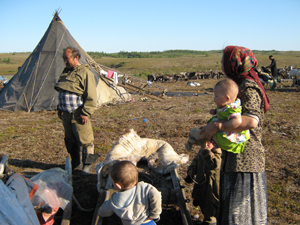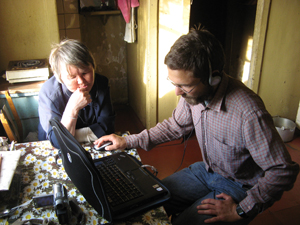Project Members
- Bernard Comrie
- Olesya Khanina
- Andrey Shluinsky
- Zoja N. Bolina (Dudinka, community collaborator)
- Viktor N. Pal'chin (Dudinka, community collaborator)
On some fieldtrips we were also joined by graduate students from Novosibirsk (Sergey Trubetskoy) and St. Petersburg (Maria Ovsjannikova).
Documentation of Enets: digitization and analysis of legacy field materials and fieldwork with last speakers

Our fieldwork-based project documented Enets, an almost extinct Northern Samoyedic language spoken on the Taimyr Peninsula, Siberia. It was funded by the ELDP for the period 01.02.2008 – 31.07.2011. The project had two general goals: first, to document phonology, morphology and natural speech of the current state of both dialects of Enets, and second, to digitize legacy audio recordings made in the 1960-1990s and to transcribe them with the help of living speakers. All Enets data obtained during the project were immediately accessible to the general public and were available from the project members or from a number of research institutions in Europe (MPI-EVA, ELAR) and Russia (Moscow, Novosibirsk, Tomsk, Dudinka).

Enets is highly endangered: there are ca. 50 speakers (all over 45) of Forest and Tundra dialects together with different levels of proficiency. The language is not used on an everyday basis.
Enets is a language with a high degree of variation in phonetics and phonology. We have documented variation in the system of back vowel phonemes (u varies with ɔ, possibly creating an intermediary /o/ phoneme), at the end of nominals unmarked for case (the final vowel may be dropped in casual speech, back rounded vowels are particularly prone to this), in the realization of the glottal stop phoneme ([ʔ], zero, glottalization of adjacent vowels), in the non-phonological gemination of intervocalic consonants, etc. The omnipresent variation between [e] and [i] in non-first syllables has led us to the conclusion that these phonemes are not differentiated beyond the first syllable.

Enets nouns are encoded for number (including dual), case, and person-number of possessor. There is also an intriguing nominal category of ‘destinativity’ which marks whether the entity is destined for someone (this person is then encoded on the noun as possessor). Possessor markers are also used for discourse related purposes, where they are completely devoid of the literal possessive meaning. Enets postpositions are marked for person-number of the noun phrase, many postpositions are formed from a small set of relational nouns with the help of archaic case morphology.

In Enets verbal morphosyntax we are particularly interested in the study of numerous contrastive constructions used for an array of pragmatic purposes: e.g. in Forest Enets there is a special contrastive cross-reference paradigm found nowhere else in Samoyedic, in Tundra Enets some negative constructions can be used in positive contexts with special pragmatics.
Enets syntax is rather typical for the family and the area: e.g. SOV, head marking in the NP, both head and dependent marking within the clause, non-finite verbal forms used for clause combining.
The outcomes of the project:
- extensive glossed text collections for the two dialects including both modern and legacy recordings (all texts are synchronized with audio);
- community materials: text collections and a picture dictionary.
Data archive
- 2980 sound files (wav, mp3)
- 400 text files (pdf, txt, doc)
- 700 annotation files (eaf)
- 4590 pictures (jpg)
Contact: lingarchive@[>>> Please remove the text! <<<]eva.mpg.de